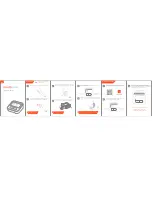
LifeSource Health Line (Toll-Free): 1-888-726-9966
5.
Insert the ear tips of the stethoscope into your ears. Adjust by
turning ear tips to fit comfortably in your ears.
6.
Hold the manometer in your left hand and the inflation bulb in
your right hand.
7.
Close the air release valve on the bulb by turning the valve
clockwise.
8.
Inflate the cuff by repeatedly squeezing the bulb with your right
hand. Listen to the pulse beat while inflating the cuff.
9.
Watch the gauge. When you can no longer hear the pulse beat,
raise the pressure an additional 30 mmHg.
NOTE: Do not inflate the cuff above 280 mmHg. You
may injure yourself or damage the equipment. If you are
uncertain about the proper cuff inflation level, consult
your physician.
10.
After reaching your inflation level, slowly deflate the cuff by
opening the air release valve. To open the air release valve, turn
it counter-clockwise so that the pressure drops 2-4 mmHg per
second. The needle on the manometer should drop an average
of one to two marks every second.
NOTE: Pressurizing the cuff shuts off all blood flow to
the arm. Do not leave it fully inflated any longer than
absolutely necessary.
TAKING YOUR BLOOD PRESSURE
E-5
LifeSource Health Line (Toll-Free): 1-888-726-9966
TAKING YOUR BLOOD PRESSURE
E-4
Now you are ready. Follow these simple steps:
1.
Sit comfortably with your left
arm resting on a flat surface
so that the center of your
upper arm is at the same
height as your heart.
2.
Lay left arm on the table with
palm up. Place the cuff on
upper arm with the tube facing
downward and toward the
inside of your arm. Fasten
cuff securely with hook and
loop fastener strap.
3.
The cuff should be snug but
not too tight. You should be
able to insert two fingers
between the cuff and your arm.
4.
With your palm facing up, place
the stethoscope head one-inch
above the bend of the elbow on
the inside of the arm. This is
where the main artery is located.



























